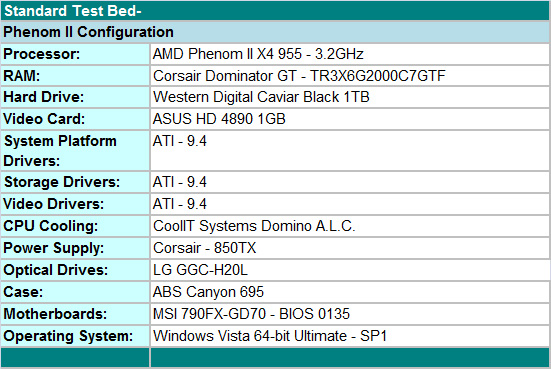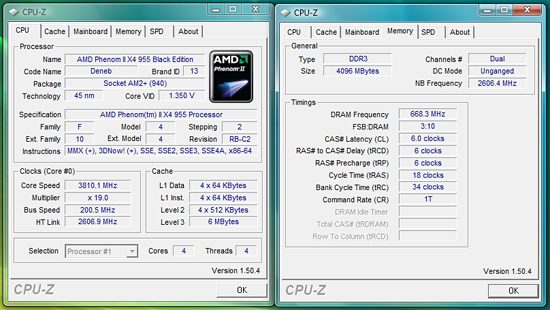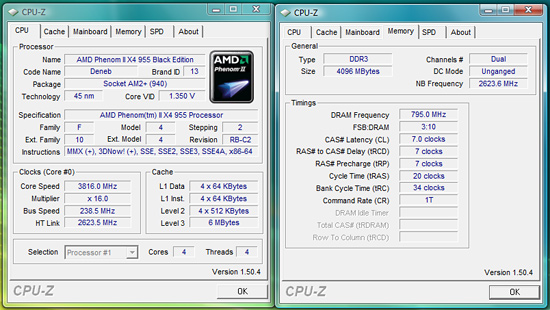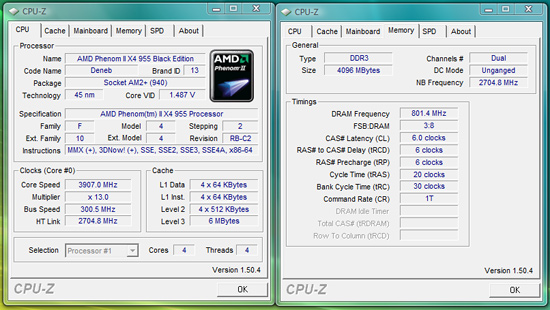AMD's Phenom II X4 955 Black Edition
by Anand Lal Shimpi on April 23, 2009 12:00 AM EST- Posted in
- CPUs
Overclocking – Adventures in Frustration
Test Setup

We put an emphasis on stability during our testing sessions so we test with real world applications ranging from a variety of games to digital imaging software to various audio/video creation programs, along with the normal OCCT and PCMark / 3DMark Vantage tests. We focus on the type of overclocks that support 24/7 operation with reasonable cooling and the ability to run a multitude of programs without a problem. We are not optimizing for SuperPI or 3DMark records. It's more like trying to keep our system stable under a variety of conditions while being properly tuned for performance.
One of the most critical aspects in overclocking is the quality of the processor. We are testing with an early retail unit based on the 0907APMW lot code. We cannot print the words to fully describe our overclocking experience with this particular CPU, let’s just say it was not a pleasant experience. The good news is that we have another retail 955 BE CPU based on lot code CACYC 0911EPMW arriving shortly for further overclocking tests. Besides having a strong processor, a well-engineered motherboard, premium memory, excellent cooling, and proper power supply are all essential elements in obtaining stable and high clock speeds when overclocking.
With that in mind, we are utilizing the MSI 790FX-GD70 (790FX) motherboard for testing today. We had similar clocking results with the ASUS M4A79T Deluxe and Gigabyte GA-MA790FXT-UD5P motherboards. At this time, we slightly prefer the MSI board based on cost, features, layout, and performance. We also tossed in the Corsair 850TX power supply along with one of the best memory kits we have ever used, the Corsair TR3X6G2000C7GTF DDR3-2000 (4GB) kit. Yes, this kit is overkill for the AM3 platform, but we wanted to ensure memory clocks or timings would not hold us back. The balance of the test system consists of a WD Caviar Black 1TB HD, Blu-ray drive from LG, Vista 64 Ultimate, and our ABS Canyon 695 case.
In a twist from our normal overclocking results, we decided to utilize the CoolIT Systems Domino A.L.C. cooler that offered a great experience when overclocking our Intel i7 920 D0 processor. Today’s test results are based on how high we could overclock on stock voltages and then by increasing voltages until we ran out of cooling headroom with the Domino cooler. Unfortunately, we never reached the limits of this cooler due to continuing problems with the Phenom II processor family and Vista 64 not allowing overclocks over 4GHz without cooling the CPU to near zero temperatures. The retail cooler would have sufficed for testing as it offered the same clock rates and voltages as our other coolers based on the operating system of choice.
On a side note, we made it to 4.2GHz on 1.50V under Vista 32 SP1, but we are still experiencing memory stability problems above DDR3-1640 with this setup. This brings us to a general problem we have noticed in testing several 790FX/790GX AM3 motherboards. DDR3 memory clocking is not very robust at this point, especially if you are expecting stable memory clocks above DDR3-1640 with 4GB or more of memory.
We have seen gradual improvement in the latest BIOS releases but for all intent and purposes, the platform performs almost equally at 1333 as it does at 1600 depending on timings. AMD designed it this way as the IMC is set up to perform best at lower memory clock speeds with tight timings. However, this does not always hold true. We have already experienced several instances where 1333 5-5-5-18 is faster than 1480 5-5-5-18 or 1600 6-7-6-20 is faster than 1800 7-7-7-24, but 1720 9-9-9-20 1T is fastest overall. At this point, we recommend DDR3-1333 5-5-5-18 1T or DDR3-1600 6-7-6-20 1T timings for the majority of users. Obviously, those benchmarking for records will want to utilize a 2GB setup and find optimal timings and speeds around DDR3-1680 to DDR3-1800, provided anything over 1700 is stable enough for benchmarking.
Phenom II X4 955 BE Maximum Overclock on Stock Voltages

Our maximum overclock on stock Core VID with the X4 955 BE resulted in a 3.8GHz clock speed at a respectable 2606MHz HT link speed and Northbridge clock at 2606MHz. Memory speed is set to DDR3-1336 at 6-6-6-18 1T on 1.50V. The primary voltages settings were left at auto in the BIOS. We tried a variety of memory speeds and timings and still ended up at 1336 on stock voltages, a slight bump to 1.55V netted us DDR3-1600 at 6-7-6-18 1T timings, although performance was nearly identical.
Phenom II X4 955 BE Maximum CPU/HT Ref Clock on Stock Voltages

Our maximum overclock on stock Core VID with HT ref clocking resulted in a 3.81GHz clock speed with a 238 HT ref clock and Northbridge speed of 2623MHz. Memory speed is set to DDR3-1590 at 7-7-7-20 1T on 1.50V. Performance in several applications was basically identical to our stock 3.8GHz overclock as memory performance did not improve enough to make a measurable difference.
Phenom II X4 955 BE Maximum CPU Overclock

Our maximum CPU overclock put us at a disappointing (embarrassing) 3.90GHz with HT link speed at 2606MHz and Northbridge speed at 2807MHz. Memory speed is set to DDR3-1604 at 6-7-6-18 1T on 1.65V. Core VID is at 1.425V and NB VID at 1.30V to ensure 24/7 stability. We tried a variety of CPU multipliers, voltages, and memory speeds but continually ran into stability problems as we approached 4GHz under Vista 64.
Phenom II X4 955 BE Maximum CPU/HT Ref Clock Speed

Our maximum CPU/HT Ref Clock settings resulted in a final processor speed of 3.907GHz. We set our HT Ref clock to 300, CPU multiplier to 13x, HT Link to 2704MHz, and NB speed to 2704MHz for this particular overclock. Memory was set to DDR3-1602 at 6-6-6-20 1T timings on 1.65V. Unfortunately, due to the HT ref clock speed, we had to increase our Core VID to 1.4875V and NB VID to 1.4375V to maintain stability. Performance was nearly identical to our 3.9GHZ utilizing just the CPU multiplier for clocking.
| Processor | Highest Overclock (Stock Voltage) | Highest Overclock (Overvolted) | % Increase over stock | Overvolted Vcore |
| AMD Phenom II X4 955 BE (3.2GHz - 1.345V) | 3.8GHz | 3.9GHz | 22% | 1.425V |
| AMD Phenom II 720 BE (2.8GHz - 1.325V) | 3.36GHz | 3.81GHz | 36% | 1.50V |
| Intel Core i7-920 C0 (2.66GHz - 1.32V) | 3.83GHz | 4.0GHz | 50% | 1.35V |
| Intel Core 2 Quad Q9550 (2.86GHz - 1.22V) | 3.48GHz | 3.91GHz | 38% | 1.35V |
We disabled the power management features and manually set the voltages to stock VID values. Leaving the BIOS settings at Auto will generally result in the BIOS auto-leveling voltages to handle the increased clock speeds for the processor, memory, and bus speeds.
We are basically OS limited with the Phenom II X4 955 BE processor. We hit 4.2GHz under Vista 32 SP1 but needed 1.50V to do it. Even so, we noticed our particular CPU sample just does not like core speeds over 4.1GHz without ramping voltages and improved cooling. We will revisit our overclocking results once additional retail units arrive. The results for the two Intel processors are very good in this particular test with the X3 720 BE managing a respectable 36% improvement in clock speeds.



























65 Comments
View All Comments
erple2 - Thursday, April 23, 2009 - link
But I think that's just it. The number of apps that use more than 2 cores is at quite a dearth, particularly given the 2 years since the 4 core processors started coming out in force.So that's just it. How many apps does one use that takes advantage of more than 2 cores? Personally, I have 2 - a compiler and an MP3 ripper. And the MP3 ripper is only marginally speedier with 2x as many cores.
So the point still stands from the Grandparent - Why do we need these 4 core behemoths (well, 4 cores with hyperthreading) when there are still so few applications that take advantage of those cores?
JimmiG - Thursday, April 23, 2009 - link
The BIOS updates situation is pretty sad. When I bought my M3A32-MVP Deluxe (790FX) board and a cheap lower-end Phenom X4, I was hoping that the board would allow me to use future 45nm Phenom CPUs without problems. That won't happen. Even though the board is technically compatible even with the 955, Asus will never release a BIOS update for this board. Asus likes to abandon its customers once the product is more than 6 months old.It's not only Asus's fault, though. AMD has been changing sockets like crazy for the last few years. S939/S754, AM2, AM2+, AM3.. Meanwhile Intel only switched sockets once with the move to i7.
slashbinslashbash - Thursday, April 23, 2009 - link
I agree, the BIOS situation is horrible. What is even worse is what you have to do to update a BIOS to use a newer processor. I will give an example, which I know is kind of extreme but it shows what's wrong with the situation.I bought an ASUS P5B a couple of years ago when CompUSA was going out of business. It was a good board for a cheap price. I didn't have any use for it at the time, as I had a good AMD S939 system running, but socked it away for future use. Couple of years later, I get a Celeron 430 + ECS mobo deal at Fry's for like $60. I put the CPU in and..... it doesn't even beep at me. I had to go and buy an ancient CPU (Pentium 630) just to get to the point where I could do the friggin' BIOS update to be able to run the newer Celeron. This, to me, is unacceptable. I'm not asking for full compatibility, just enough smarts to realize that this is a working processor plugged in, so can't we just run it at some minimum specs and pop up a "Please Update BIOS" message on the screen, and allow that BIOS update to run?
I totally understand CPU-mobo mismatches if the newer CPU requires a lower voltage or something like that. But, if the CPU is compatible, it ought to run in some minimal state necessary to at least load a BIOS update. Ideally, it would run some microkernel with networking that could automatically FTP the latest BIOS from the manufacturer; but that's probably too much to ask.
spunlex - Thursday, April 23, 2009 - link
Some motherboards do. My abit ip-35 pro ran my q9450 at 2.2Ghz, under the wrong name until I flashed the bios. So it is possible it seems to depend on the effort the board manufacturer is willing to make.strikeback03 - Thursday, April 23, 2009 - link
Just because a board uses Socket 775 doesn't necessarily mean it can use all S775 processors, my P965 board doesn't list compatibility with any 1333FSB processors.Roland00 - Thursday, April 23, 2009 - link
AMDSocket 939 June 2004
AM2 May 2006
AM2+ Nov 2007
AM3 February 2009
Intel
473 Nov 00
478 Aug 01
775 June 2004
1366 Nov 08
Now intel may recently have been not releasing new sockets as quickly as AMD, but during the Pentium 4 days from 473 to 478 to 775 they were releasing new sockets as quickly as AMD did during the AM2 era. And while you had the same socket 775 for 4 years it wasn't guaranteed that the newer cpus will work on your motherboard (see nvidia chipsets which wouldn't allow you to upgrade from a Pentium 4 to a Pentium d or a 65nm part to a 45 nm part). How is that different than AM2+ processors being compatible with AM2 boards if the bios maker just released a stupid bios.
JarredWalton - Thursday, April 23, 2009 - link
Let's not forget for socket 775 you had:Pentium 4 Northwood, Prescott - I don't *think* there was any compatibility issue here, though I'm sure some boards didn't support new Prescott chips, and of course there were new FSB speeds that required a new board/chipset
Pentium D Smithfield - yes, another chipset/board upgrade was needed.
Pentium D Presler - sadly, many boards didn't support this update either, since it used a 1066FSB.
Conroe/Allendale - definitely needs new board/chipset, but mostly compatible with all new "Core" CPUs.
Kentsfield - many boards wouldn't support quad core, so you needed to upgrade.
Wolfdale/Yorkfield - yet again, many need an updated board.
Or we could just list chipsets:
865/875 - adds 800FSB
910/915/920 - PCI-E and DDR2 support. Prescott also.
945/955 - 1066FSB and Pentium D
965/975 - Initial Core 2 chipsets; Core 2 Quad not supported on all boards
P35/X38 - adds support for 1333FSB, initial DDR3 support starts
P45 - Generally needed for Wolfdale/Yorkfield support
X48 - adds official 1600FSB (only needed for Q9770)
So while socket 775 has been around "forever", we have had no less than six chipset families in that time - and that's just the Intel chipsets. NVIDIA would add quite a few more to the mix. Naturally, AMD wasn't without fault - there were 939 boards that wouldn't work with dual-core chips, and later AM2 boards that don't work with Phenom. Now we have AM2+ that won't work with AM3 chips.
All this goes back to my general attitude of never purchasing a motherboard for its "future proof" capabilities. Get a board because it has what you want/need right now, and when it's time to upgrade then reevaluate your needs.
swaaye - Sunday, July 5, 2009 - link
My 'ol P965 board can technically run the latest Wolfdale CPU. You have to overclock the FSB to 1600, but that's no big deal really cuz I run a Conroe past that anyway lol. Gigabyte keeps things up to date as long as there isn't some serious hardware level incompatibility.Some 945 boards can run the latest stuff too as long as it's 800 FSB.
Really, the sockets change because the CPU maker figured out that the older spec didn't do the trick for some reason. I find it curious that people think that sockets should last for many CPU generations, as if the socket has little to do in the grand scheme of things.
crimson117 - Thursday, April 23, 2009 - link
Ditto... I got burned buying socket 939 x2 4400+ right when the it came out (July 2005), expecting to have a drop-in CPU upgrade in the next year or two. Boy was I pissed when it was replaced by Socket AM2 in May 2006, just 10 months later. (and also pissed that nothing much faster than the 4400+ was ever released on 939).Do they really get so much benefit from changing sockets that losing compatibility is worth it?
JarredWalton - Thursday, April 23, 2009 - link
I think honestly that a large percentage of chipset/mobo updates are to help companies make money and not for any serious benefit. It's usually at best a 2-5% boost in performance for stuff like new memory technology, tweaked chipset, etc.